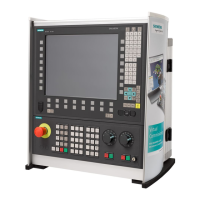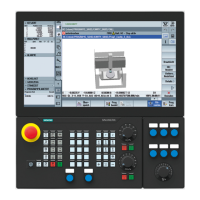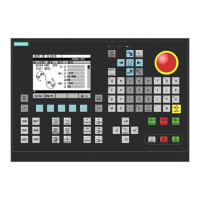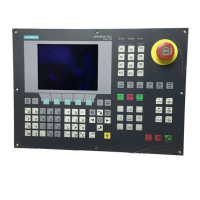Detailed Description
2.8 Auxiliary function output to PLC (H2)
NC/PLC Interface Signals (Z1)
2-78 Function Manual, 08/2005 Edition, 6FC5397-0BP10-0BA0
DB21, ...
DBB158 - DBB193
F functions 1 to 6
Extended address F functions 1 to 6
Edge evaluation: no Signal(s) updated: Job-controlled by NCK
Signal state 1 or
edge change
0 → 1
Up to 6 F functions (one path feed and up to 5 axis-specific feeds for
positioning axes) are made available here simultaneously as soon as the F change
signals are available.
Value range of F function: Floating point (corresponding to the MC5+format)
Value range of the extended address: 0 to 18; integer number
The extended address of the F function is generated from the feed type (path feed or axis-specific
feed) and the axis names.
It is coded as follows:
3DWKIHHGHJ) HJ)
0DFKLQHD[LVQXPEHURIWKHSRVLWLRQLQJD[LV
IRUDQD[LVVSHFLILFIHHG
HJ)$>;@
WR
The F functions remain until they are overwritten by new F functions.
Signal state 0 or
edge change
1 → 0
• After the PLC has ramped-up.
• All help functions are deleted before a new function is entered.
Application
example(s)
Control of programmed F word by the PLC, e.g. through overwriting of the set feed rate override.
Corresponding to .... MD 22240 $MC_AUXFU_F_SYNC_TYPE (instant in time that the F functions are output)
DB21, ...
DBB194 - DBB206
Dynamic M functions: M0 - M99
Edge evaluation: no Signal(s) updated: Job-controlled by NCK
Signal state 1 or
edge change
0 → 1
The dynamic M signal bits are set by decoded M functions.
Signal state 0 or
edge change
1 → 0
For a general help function output, the dynamic M signal bits are acknowledged by the PLC basic
program after the OB1 has been completely run-through (executed once).
For a fast help function output, after the PLC identifies the help functions, they are acknowledged in
the same OB40 cycle.
Application
example(s)
Spindle clockwise/counterclockwise rotation, switch coolant ON/OFF
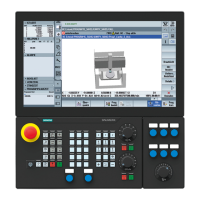
